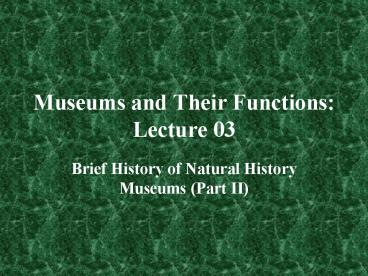Museums and Their Functions: Lecture 03 - PowerPoint PPT Presentation
1 / 24
Title:
Museums and Their Functions: Lecture 03
Description:
Old and new objects would be placed together. ... Natural objects are understood by ... Great Chain of Being, grouping nature along a hierarchical scale. ... – PowerPoint PPT presentation
Number of Views:127
Avg rating:3.0/5.0
Title: Museums and Their Functions: Lecture 03
1
Museums and Their Functions Lecture 03
- Brief History of Natural History Museums (Part II)
2
Classical or Pre-Linnaean Period
Old and new objects would be placed together.
No distinctions would be made between real and
replicated objects.
Integrity of objects was not important.
3
Linnaean Period (1750-1850)
- Distinguished from Classical Period by
- Natural objects are understood by functional
characteristics rather than by superficial
similarities.
- Objective was to discover how natural objects are
related and the means were analogy and succession.
- Relationships between things were conceived in
the form of order and measurement.
- Attempts were made to distinguish and classify
nature in a hierarchical manner.
4
Royal College of Surgeons
c, Royal College of Surgeons, London (1837).
Yanni (1999)
5
Hunterian Museum, Royal College of Surgeons, Main
Room (1845).
Hunterian Museum, Royal College of Surgeons, Main
Room (1845). From Yanni (1999)
6
Cambridge University Library, Natural History
Collection (1842).
Cambridge University Library, Natural History
Collection (1842). From Yanni (1999)
7
British Museum, Montagu House, London (1845).
British Museum, Montagu House, London (1845).
From Yanni (1999)
8
Linnaean Period (1750-1850)
- Period of great expansion of natural history
collections and classification of life.
- Trend of specialization of museums continued.
- Collections changed from private to public
ownership, organized by academic societies.
9
Muséum National dHistoire Naturelle, Paris,
Zoology Galleries (1815).
Muséum National dHistoire Naturelle, Paris,
Zoology Galleries (1815). From Outram (1996)
10
Jardin des Plantes, Paris 19th Century (Muséum
National dHistoire Naturelle).
Jardin des Plantes, Paris 19th Century (Muséum
National dHistoire Naturelle).
11
Jardin des Plantes, Paris 19th Century (Muséum
National dHistoire Naturelle).
Jardin des Plantes, Paris 19th Century (Muséum
National dHistoire Naturelle).
12
Muséum National dHistoire Naturelle, Paris
(Galerie de Zoologie).
Muséum National dHistoire Naturelle, Paris
(Galerie de Zoologie).
13
Linnaean Period (1750-1850)
- Great Chain of Being, grouping nature along a
hierarchical scale.
- Carl Linnaeus (1707-1778) father of nomenclature,
and proposed the first modern classifications of
plants and animals. His Systema naturae is the
basis of modern classification. Served as means
of arranging museums.
- Linnaeus encouraged his students to travel the
world in search of biota.
14
Modern Period (1850-present)
- Distinguished from the Linnaean period by
- Charles Darwin (1809-1882) provided the paradigm.
- Analogous and homologous natural items were
distinguished, and the former was used in
classifying.
- Objective was to discover how natural items are
related and the means were homology and
succession.
- Technology was better developed for
classification of natural items.
15
Modern Period (1850-present)
- Institutionalization of museums.
- Collecting of natural items became a very active
and complex process. Large expeditions were
mounted.
- Collection building continued rapidly through the
early part of the 20th Century.
- Museums became state institutions and were open
to the public.
- Museums were (in part) designed to reflect
societal or government values.
16
Naturmuseum and Forschungs Institute Senckenburg,
room 5, Frankfurt (1915).
Naturmuseum and Forschungs Institute Senckenburg,
room 5, Frankfurt (1915). Est. 1817. Largely
destroyed during WW II.
17
Naturmuseum and Forschungs Institute Senckenburg,
Room 5, Frankfurt (1985).
Naturmuseum and Forschungs Institute Senckenburg,
Room 5, Frankfurt (1985).
18
Modern Period (1850-present)
- Museums took on new educational duties to reflect
their role in egalitarian and democratic
societies.
- More emphasis placed on adapting education for
museum visitors.
- The educational role of modern museums is still
in transition.
19
Museum of Science and Industry, Chicago
Museum of Science and Industry, Chicago
20
Synopsis
- Museums have been active in shaping knowledge for
the last 600 years.
- Structure of knowledge varies with time.
- Material artifacts are important in knowing the
world but type of artifact and manner of display
vary with world view.
- There is no essential definition of museums
because definition varies with the world view of
societies.
21
Synopsis
- Example of how meanings of the same object vary
according to time and shifts in the world view
Madonna and child
- Renaissance Period (Medici Palace) Magical and
religious object.
- Renaissance Period (Cabinet of World) Part of
representation of hierarchical structure of
World.
- Classical Period (Pre-Linnaean Period) Would be
considered outside realm of nature.
22
Synopsis
- Example continued
- Modern Period Would be treated historically
according the artistic school of the artist.
- Thus objects have no essential identity, meaning
is not constant, and processes of keeping and
sorting vary with time.
- Meaningful objects are in a state of flux, and
are often reformulated over time.
23
Synopsis
- In the modern age, it is no longer enough for
natural objects to present themselves on a table
of knowledge.
- The importance of objects is in their relation to
humankind.
- Objects are now presented as their relationships
to humankind (thematic approach).
24
Credits and References
Hooper-Greenhill, E. 1992. Chapter 6. The
Repository of the Royal Society. pp. 133-166. New
York. 232 pp.
Hooper-Greenhill, E. 1992. Chapter 7, The
disciplinary museum. Pp. 167-190. New York. 232
pp.
Hooper-Greenhill, E. 1992. Chapter 8. A useful
past for the present. pp. 191-215. New York. 232
pp.
Outram, D. 1996. New spaces in natural history.
Pp. 249-265.
Whitehead, P.J.P. 1971. Museums and the history
of zoology. (part II). Mus. J. 70 155-160.
Yani, C. 1999. Natures museums. Victorian
science the architecture of display. The Johns
Hopkins University Press.199 pp.































